Year 0 Foundation English Academic Skills 1: Zara SWOT Analysis Essay
VerifiedAdded on 2022/09/17
|5
|1174
|26
Essay
AI Summary
This essay presents a SWOT analysis of Zara, a prominent apparel retailer. The analysis examines Zara's internal strengths, such as its ability to meet customer demands for new products and its control over design, manufacturing, and supply. It also identifies weaknesses, including the challenges of managing operations across multiple countries and the risk associated with its fast-fashion design strategy. The essay explores opportunities for Zara, such as expansion into emerging markets and e-commerce, and addresses potential threats from competitors and rising production costs. The conclusion highlights Zara's strengths in its unique business strategies but also acknowledges the need for continuous improvement to maintain a competitive advantage. The essay is supported by references to academic sources.
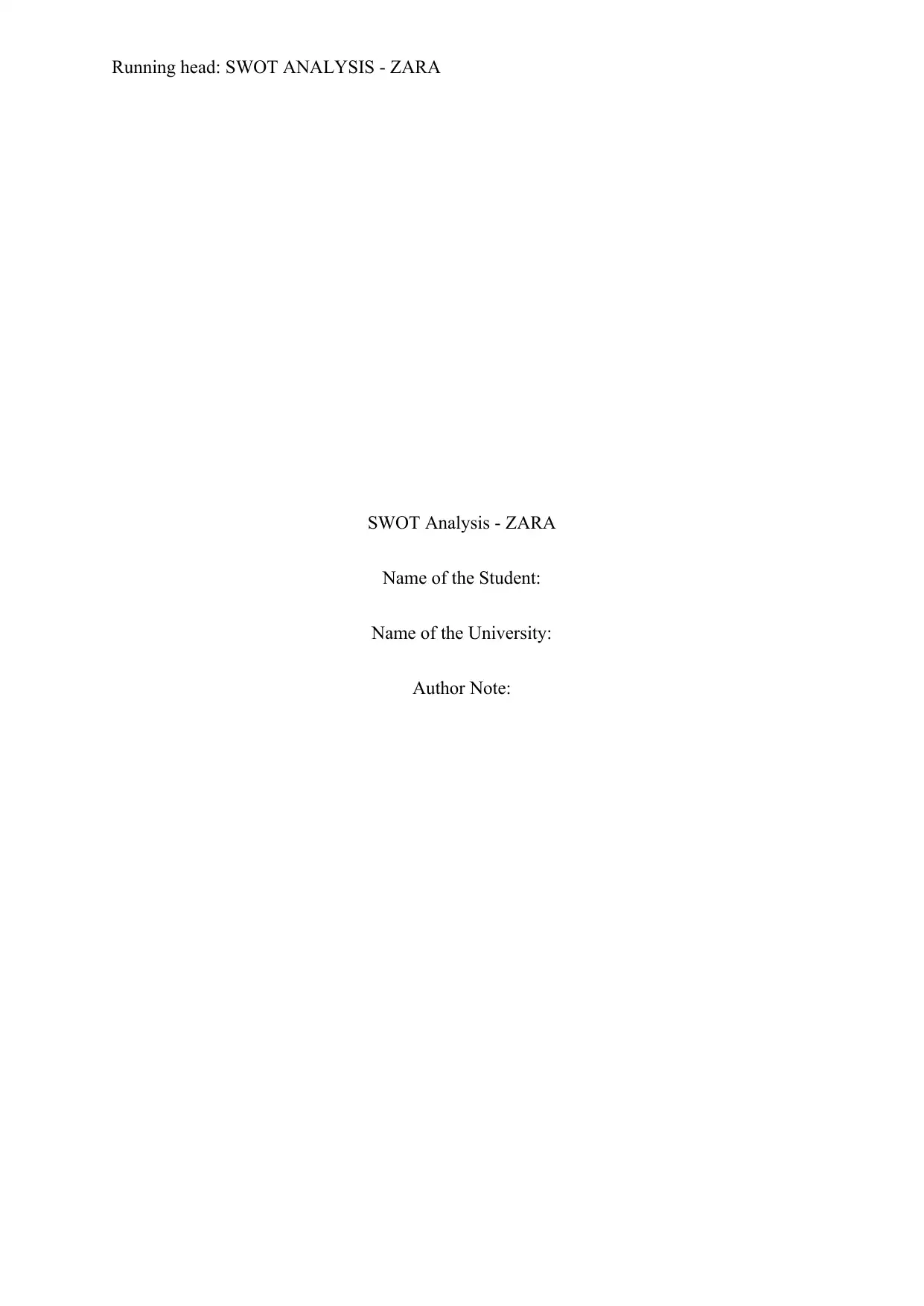
Running head: SWOT ANALYSIS - ZARA
SWOT Analysis - ZARA
Name of the Student:
Name of the University:
Author Note:
SWOT Analysis - ZARA
Name of the Student:
Name of the University:
Author Note:
Paraphrase This Document
Need a fresh take? Get an instant paraphrase of this document with our AI Paraphraser
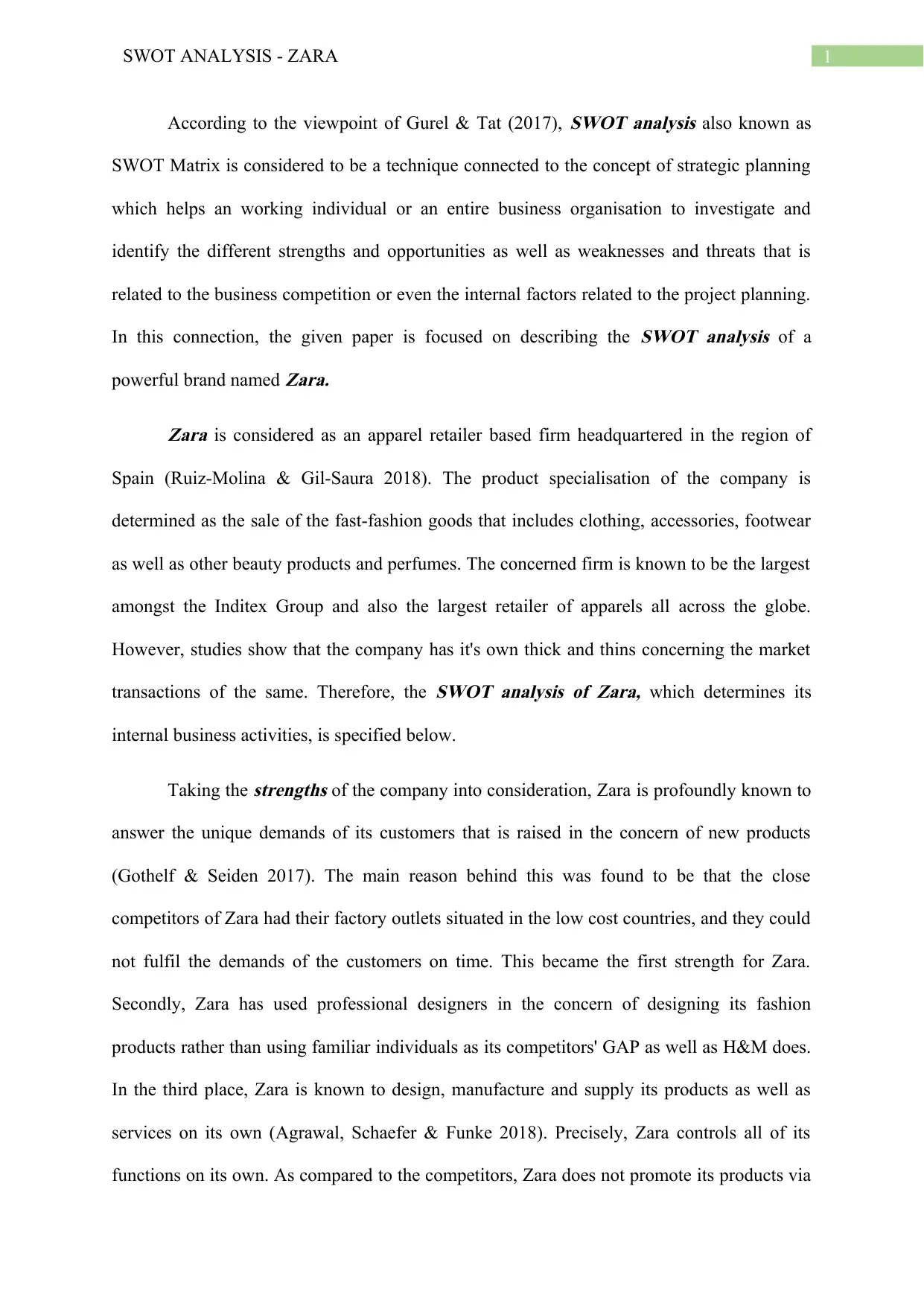
1SWOT ANALYSIS - ZARA
According to the viewpoint of Gurel & Tat (2017),
SWOT analysis also known as
SWOT Matrix is considered to be a technique connected to the concept of strategic planning
which helps an working individual or an entire business organisation to investigate and
identify the different strengths and opportunities as well as weaknesses and threats that is
related to the business competition or even the internal factors related to the project planning.
In this connection, the given paper is focused on describing the
SWOT analysis of a
powerful brand named
Zara.
Zara is considered as an apparel retailer based firm headquartered in the region of
Spain (Ruiz-Molina & Gil-Saura 2018). The product specialisation of the company is
determined as the sale of the fast-fashion goods that includes clothing, accessories, footwear
as well as other beauty products and perfumes. The concerned firm is known to be the largest
amongst the Inditex Group and also the largest retailer of apparels all across the globe.
However, studies show that the company has it's own thick and thins concerning the market
transactions of the same. Therefore, the
SWOT analysis of Zara, which determines its
internal business activities, is specified below.
Taking the
strengths of the company into consideration, Zara is profoundly known to
answer the unique demands of its customers that is raised in the concern of new products
(Gothelf & Seiden 2017). The main reason behind this was found to be that the close
competitors of Zara had their factory outlets situated in the low cost countries, and they could
not fulfil the demands of the customers on time. This became the first strength for Zara.
Secondly, Zara has used professional designers in the concern of designing its fashion
products rather than using familiar individuals as its competitors' GAP as well as H&M does.
In the third place, Zara is known to design, manufacture and supply its products as well as
services on its own (Agrawal, Schaefer & Funke 2018). Precisely, Zara controls all of its
functions on its own. As compared to the competitors, Zara does not promote its products via
According to the viewpoint of Gurel & Tat (2017),
SWOT analysis also known as
SWOT Matrix is considered to be a technique connected to the concept of strategic planning
which helps an working individual or an entire business organisation to investigate and
identify the different strengths and opportunities as well as weaknesses and threats that is
related to the business competition or even the internal factors related to the project planning.
In this connection, the given paper is focused on describing the
SWOT analysis of a
powerful brand named
Zara.
Zara is considered as an apparel retailer based firm headquartered in the region of
Spain (Ruiz-Molina & Gil-Saura 2018). The product specialisation of the company is
determined as the sale of the fast-fashion goods that includes clothing, accessories, footwear
as well as other beauty products and perfumes. The concerned firm is known to be the largest
amongst the Inditex Group and also the largest retailer of apparels all across the globe.
However, studies show that the company has it's own thick and thins concerning the market
transactions of the same. Therefore, the
SWOT analysis of Zara, which determines its
internal business activities, is specified below.
Taking the
strengths of the company into consideration, Zara is profoundly known to
answer the unique demands of its customers that is raised in the concern of new products
(Gothelf & Seiden 2017). The main reason behind this was found to be that the close
competitors of Zara had their factory outlets situated in the low cost countries, and they could
not fulfil the demands of the customers on time. This became the first strength for Zara.
Secondly, Zara has used professional designers in the concern of designing its fashion
products rather than using familiar individuals as its competitors' GAP as well as H&M does.
In the third place, Zara is known to design, manufacture and supply its products as well as
services on its own (Agrawal, Schaefer & Funke 2018). Precisely, Zara controls all of its
functions on its own. As compared to the competitors, Zara does not promote its products via
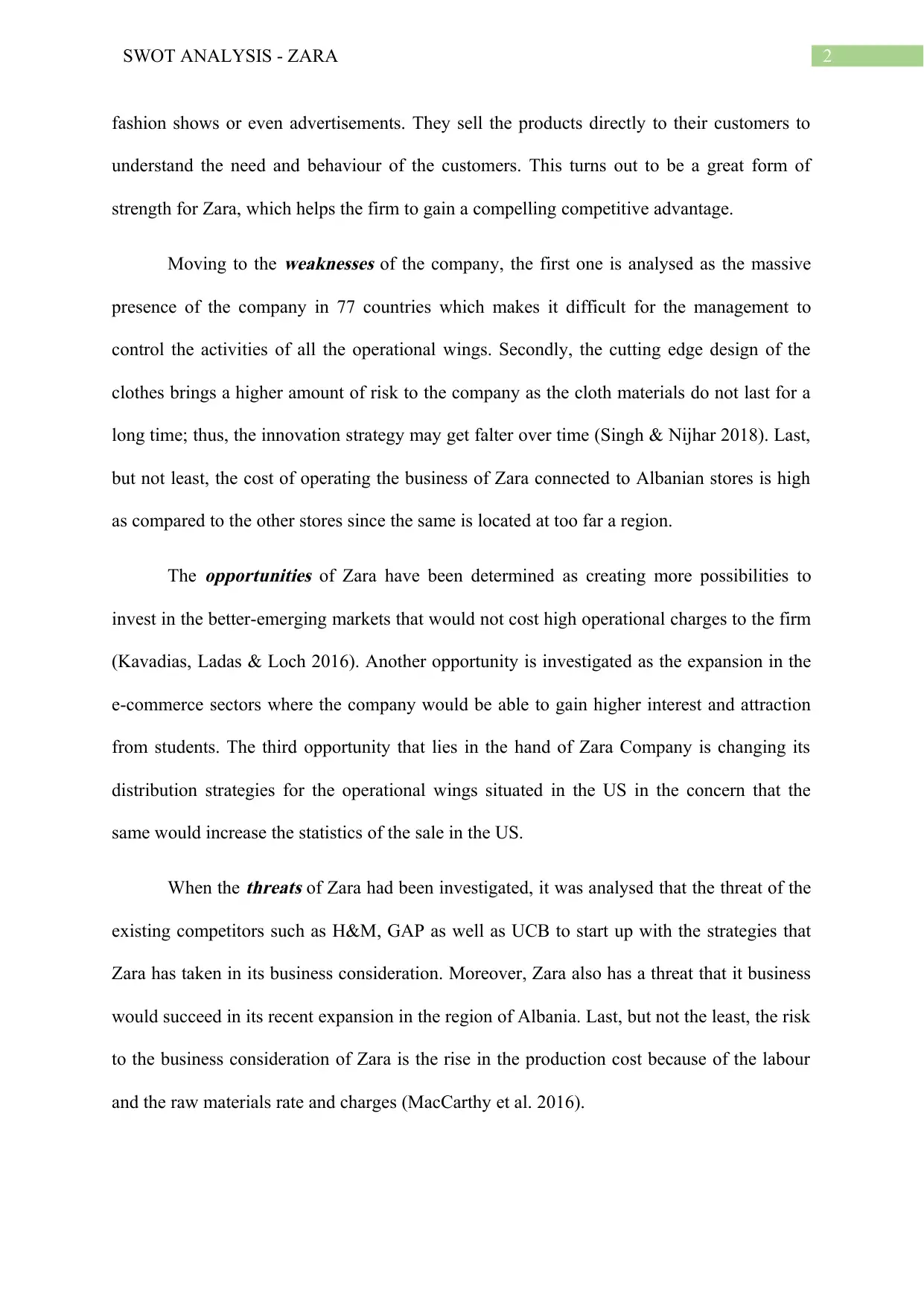
2SWOT ANALYSIS - ZARA
fashion shows or even advertisements. They sell the products directly to their customers to
understand the need and behaviour of the customers. This turns out to be a great form of
strength for Zara, which helps the firm to gain a compelling competitive advantage.
Moving to the
weaknesses of the company, the first one is analysed as the massive
presence of the company in 77 countries which makes it difficult for the management to
control the activities of all the operational wings. Secondly, the cutting edge design of the
clothes brings a higher amount of risk to the company as the cloth materials do not last for a
long time; thus, the innovation strategy may get falter over time (Singh & Nijhar 2018). Last,
but not least, the cost of operating the business of Zara connected to Albanian stores is high
as compared to the other stores since the same is located at too far a region.
The
opportunities of Zara have been determined as creating more possibilities to
invest in the better-emerging markets that would not cost high operational charges to the firm
(Kavadias, Ladas & Loch 2016). Another opportunity is investigated as the expansion in the
e-commerce sectors where the company would be able to gain higher interest and attraction
from students. The third opportunity that lies in the hand of Zara Company is changing its
distribution strategies for the operational wings situated in the US in the concern that the
same would increase the statistics of the sale in the US.
When the
threats of Zara had been investigated, it was analysed that the threat of the
existing competitors such as H&M, GAP as well as UCB to start up with the strategies that
Zara has taken in its business consideration. Moreover, Zara also has a threat that it business
would succeed in its recent expansion in the region of Albania. Last, but not the least, the risk
to the business consideration of Zara is the rise in the production cost because of the labour
and the raw materials rate and charges (MacCarthy et al. 2016).
fashion shows or even advertisements. They sell the products directly to their customers to
understand the need and behaviour of the customers. This turns out to be a great form of
strength for Zara, which helps the firm to gain a compelling competitive advantage.
Moving to the
weaknesses of the company, the first one is analysed as the massive
presence of the company in 77 countries which makes it difficult for the management to
control the activities of all the operational wings. Secondly, the cutting edge design of the
clothes brings a higher amount of risk to the company as the cloth materials do not last for a
long time; thus, the innovation strategy may get falter over time (Singh & Nijhar 2018). Last,
but not least, the cost of operating the business of Zara connected to Albanian stores is high
as compared to the other stores since the same is located at too far a region.
The
opportunities of Zara have been determined as creating more possibilities to
invest in the better-emerging markets that would not cost high operational charges to the firm
(Kavadias, Ladas & Loch 2016). Another opportunity is investigated as the expansion in the
e-commerce sectors where the company would be able to gain higher interest and attraction
from students. The third opportunity that lies in the hand of Zara Company is changing its
distribution strategies for the operational wings situated in the US in the concern that the
same would increase the statistics of the sale in the US.
When the
threats of Zara had been investigated, it was analysed that the threat of the
existing competitors such as H&M, GAP as well as UCB to start up with the strategies that
Zara has taken in its business consideration. Moreover, Zara also has a threat that it business
would succeed in its recent expansion in the region of Albania. Last, but not the least, the risk
to the business consideration of Zara is the rise in the production cost because of the labour
and the raw materials rate and charges (MacCarthy et al. 2016).
⊘ This is a preview!⊘
Do you want full access?
Subscribe today to unlock all pages.

Trusted by 1+ million students worldwide
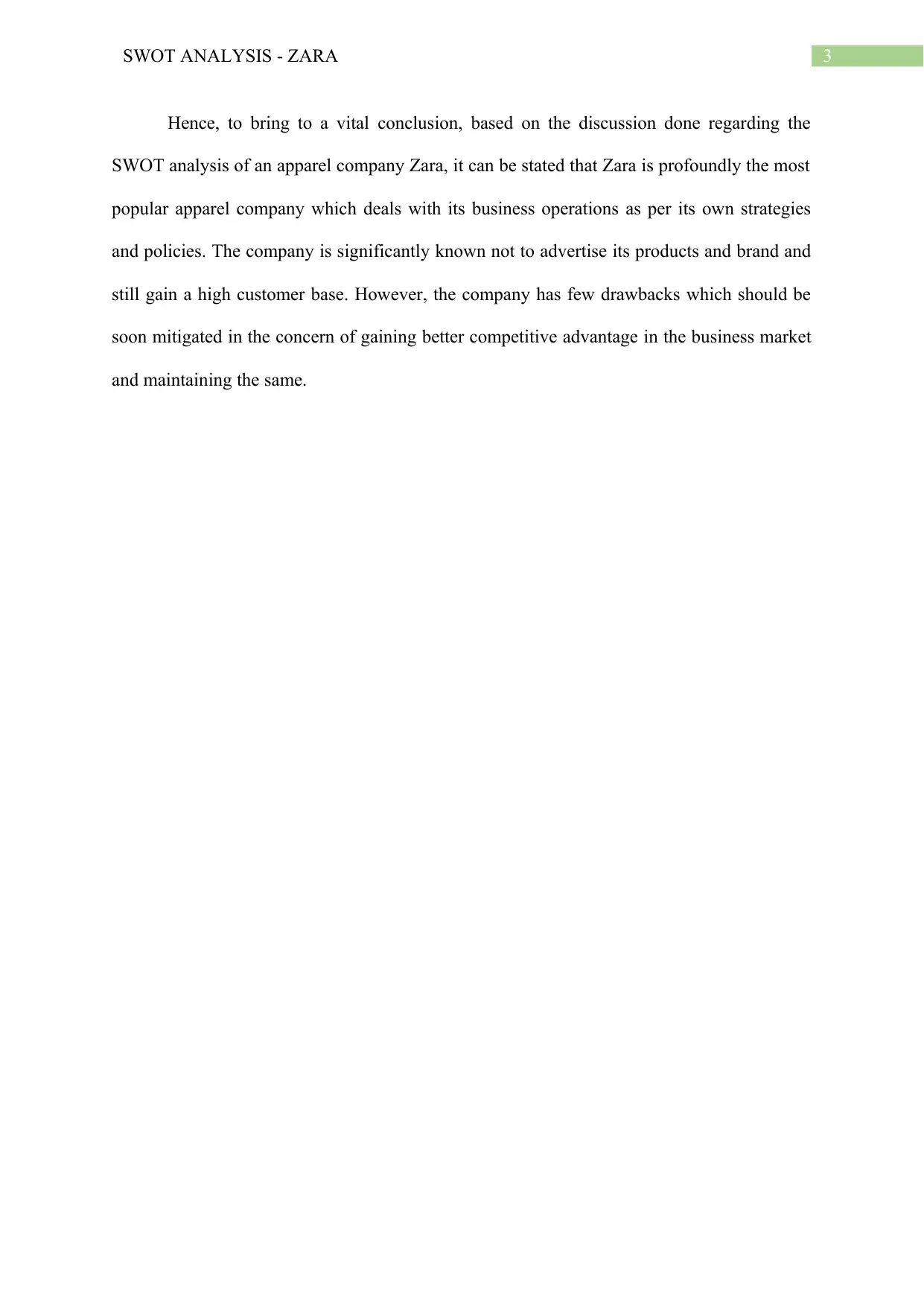
3SWOT ANALYSIS - ZARA
Hence, to bring to a vital conclusion, based on the discussion done regarding the
SWOT analysis of an apparel company Zara, it can be stated that Zara is profoundly the most
popular apparel company which deals with its business operations as per its own strategies
and policies. The company is significantly known not to advertise its products and brand and
still gain a high customer base. However, the company has few drawbacks which should be
soon mitigated in the concern of gaining better competitive advantage in the business market
and maintaining the same.
Hence, to bring to a vital conclusion, based on the discussion done regarding the
SWOT analysis of an apparel company Zara, it can be stated that Zara is profoundly the most
popular apparel company which deals with its business operations as per its own strategies
and policies. The company is significantly known not to advertise its products and brand and
still gain a high customer base. However, the company has few drawbacks which should be
soon mitigated in the concern of gaining better competitive advantage in the business market
and maintaining the same.
Paraphrase This Document
Need a fresh take? Get an instant paraphrase of this document with our AI Paraphraser
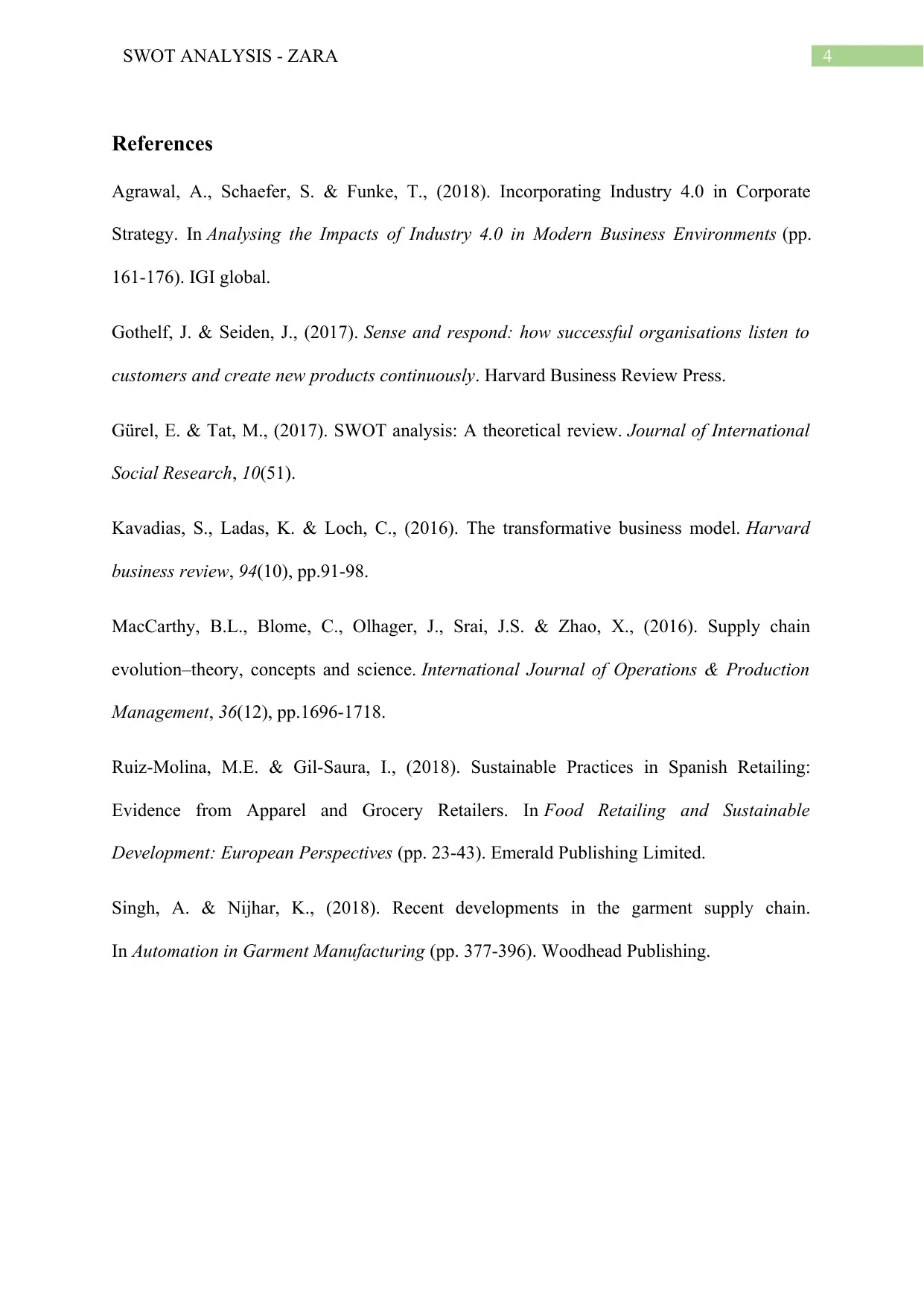
4SWOT ANALYSIS - ZARA
References
Agrawal, A., Schaefer, S. & Funke, T., (2018). Incorporating Industry 4.0 in Corporate
Strategy. In Analysing the Impacts of Industry 4.0 in Modern Business Environments (pp.
161-176). IGI global.
Gothelf, J. & Seiden, J., (2017). Sense and respond: how successful organisations listen to
customers and create new products continuously. Harvard Business Review Press.
Gürel, E. & Tat, M., (2017). SWOT analysis: A theoretical review. Journal of International
Social Research, 10(51).
Kavadias, S., Ladas, K. & Loch, C., (2016). The transformative business model. Harvard
business review, 94(10), pp.91-98.
MacCarthy, B.L., Blome, C., Olhager, J., Srai, J.S. & Zhao, X., (2016). Supply chain
evolution–theory, concepts and science. International Journal of Operations & Production
Management, 36(12), pp.1696-1718.
Ruiz-Molina, M.E. & Gil-Saura, I., (2018). Sustainable Practices in Spanish Retailing:
Evidence from Apparel and Grocery Retailers. In Food Retailing and Sustainable
Development: European Perspectives (pp. 23-43). Emerald Publishing Limited.
Singh, A. & Nijhar, K., (2018). Recent developments in the garment supply chain.
In Automation in Garment Manufacturing (pp. 377-396). Woodhead Publishing.
References
Agrawal, A., Schaefer, S. & Funke, T., (2018). Incorporating Industry 4.0 in Corporate
Strategy. In Analysing the Impacts of Industry 4.0 in Modern Business Environments (pp.
161-176). IGI global.
Gothelf, J. & Seiden, J., (2017). Sense and respond: how successful organisations listen to
customers and create new products continuously. Harvard Business Review Press.
Gürel, E. & Tat, M., (2017). SWOT analysis: A theoretical review. Journal of International
Social Research, 10(51).
Kavadias, S., Ladas, K. & Loch, C., (2016). The transformative business model. Harvard
business review, 94(10), pp.91-98.
MacCarthy, B.L., Blome, C., Olhager, J., Srai, J.S. & Zhao, X., (2016). Supply chain
evolution–theory, concepts and science. International Journal of Operations & Production
Management, 36(12), pp.1696-1718.
Ruiz-Molina, M.E. & Gil-Saura, I., (2018). Sustainable Practices in Spanish Retailing:
Evidence from Apparel and Grocery Retailers. In Food Retailing and Sustainable
Development: European Perspectives (pp. 23-43). Emerald Publishing Limited.
Singh, A. & Nijhar, K., (2018). Recent developments in the garment supply chain.
In Automation in Garment Manufacturing (pp. 377-396). Woodhead Publishing.
1 out of 5
Related Documents
Your All-in-One AI-Powered Toolkit for Academic Success.
+13062052269
info@desklib.com
Available 24*7 on WhatsApp / Email
![[object Object]](/_next/static/media/star-bottom.7253800d.svg)
Unlock your academic potential
Copyright © 2020–2025 A2Z Services. All Rights Reserved. Developed and managed by ZUCOL.





